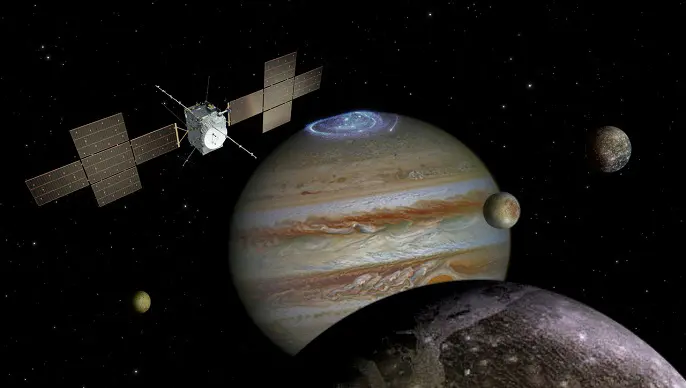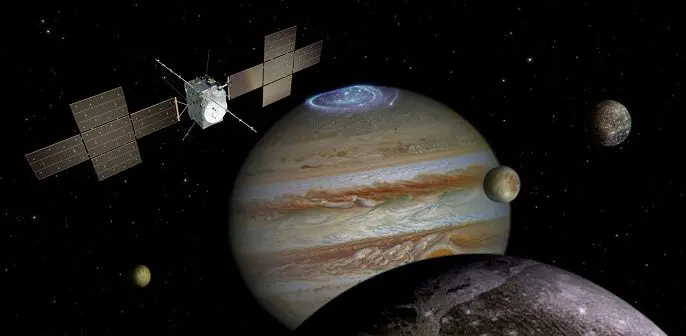
Written by Staff Writer.
European Space Agency (ESA) Director General says the April launch of the JUpiter ICy Moons Explorer (JUICE) spacecraft is one of Europe’s most exciting and important space missions this year. The spacecraft, which will take eight years to fly to Jupiter before commencing flybys of its satellite moons, is due to hitch a ride onboard the last Ariana 5 rocket to lift off from the ESA’s spaceport at Kourou, French Guiana, on April 14, 2023.
“It’s an important mission for Europe from a science and industry point of view,” said ESA Director General Josef Aschbacher at the agency’s recent annual press conference. “Certainly, a highlight of the year from many points of year… what this mission will bring is a better understanding of the outer solar system of Jupiter, but in particular, the icy moons.”
Jupiter is over 817 million kilometres from Earth. The spacecraft, developed by the ESA with Airbus Defence and Space as the main contractor, will have onboard ten instruments. These include the JANUS camera system; UVS ultraviolet imaging spectrograph; MAJIS visible and infrared imaging spectrometer; GALA laser altimeter; RIME radar sounder; J-MAG magnetometer; SWI submillimeter wave instrument; PRIDE radio science instrument; 3GM radio science package; and PEP particle and plasma package.
Ariana 5’s launch window is between April 14 and April 30, with the 14th the target day. “As always with launch day, there may be some variations,” warns Aschbacher. Once in orbit, JUICE will take six years to complete 25 ever-enlarging planned gravity assists before it veers off on its Jupiter-bound trajectory in 2029. Along the way, there will be a flyby of Venus in 2025, two trips through asteroid belts, and a possible 2029 flyby of the asteroid 223 Rosa.
All going well, JUICE will arrive in Jupiter’s system in July 2031. Then for three and a half years, the spacecraft will survey Jupiter and its three large ocean-bearing moons, Ganymede, Callisto and Europa.
“These icy moons are just so fascinating,” said Aschbacher. “They have an ice cover which is quite thick, tens of kilometres, up to 100 kilometres thick. Underneath are huge lakes, again tens of kilometres, 100 kilometres deep, much deeper than the oceans on Earth.”
“We really want to explore how these moons are composed, to see whether they have the potential for habitability. To be clear, we are not looking for life. We are not here to monitor fish or big creatures in these lakes, but we are seeing how these moons are composed and whether they could be habitable or not.”
When first proposed in 2012, the ESA said JUICE would cost around US1.1 billion dollars. ESA’s spacecraft follows NASA’s Juno spacecraft, which arrived at Jupiter in 2016 and has now spent over six and a half years orbiting and surveying the solar system’s largest planet and its moons.
JUICE’s launch mass will be just over 6,000 kilograms, half of that being fuel. Solar arrays employing gallium arsenide solar cells measuring 60 – 75 square meters will provide much of the spacecraft’s power over its lifespan, but JUICE will need the liquid fuel for orbit insertions and manoeuvres. Unfortunately, the ESA has planned no return to Earth or endless space journey for JUICE. In 2035, after using the last of its fuel, the spacecraft will be “deorbited” and sent on a collision course with Ganymede.
Image: Artist’s concept of JUICE spacecraft at Jupiter. Credit: ESA





